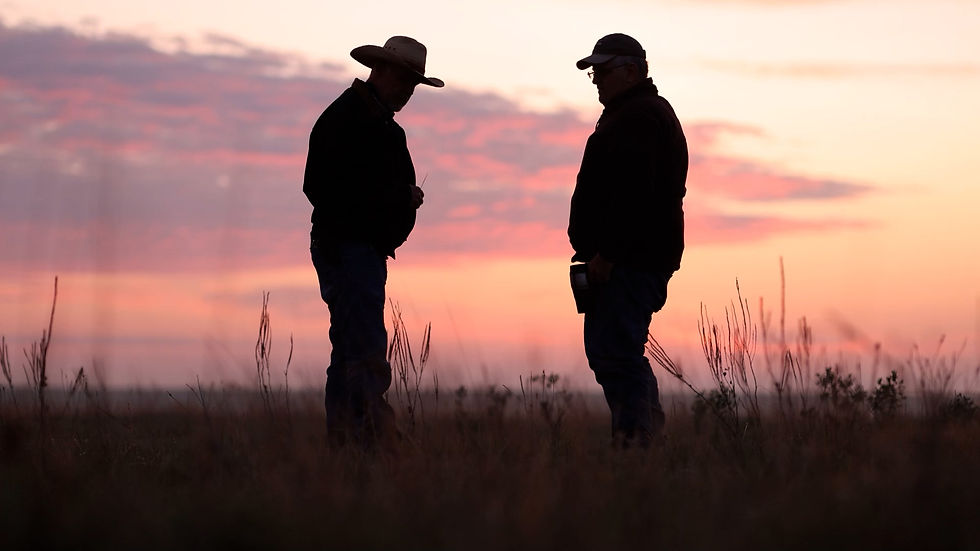Soil Compaction Fixes: Dr. Ray Weil on Deep Roots & Water
- mtsausen
- Aug 11
- 3 min read

When I first started learning about soil, I wasn’t a trained agronomist—I just knew we were supposed to take soil samples down to 6" or 6¼". I didn’t question it at the time.
Later, I learned that this 6" layer represents the old plow layer—the zone where most agronomic roots live. But here’s the kicker: they live there not because it’s ideal, but because the plow created a compacted “plow pan” beneath it. This dense, platy layer restricts root growth, moisture movement, and gas exchange. In effect, we were farming in flower pots.
I remember standing with Dr. Ray Weil (co-author of The Nature and Properties of Soils) in October 2014 at Steve Groff’s farm in Pennsylvania. The no-till field we were looking at had been farmed without tillage for over 30 years. We were in a seven-foot-deep soil pit—well over my head, and I’m six feet tall—looking at roots, soil layers, and what Ray called “a huge tank” of deeper water and nutrients separated from crops by a compacted zone.
Ray’s message was simple: in many fields, roots can’t reach that tank. They’re blocked by the compaction left behind by decades of tillage, and without a path down, crops hit summer stress and yields drop.
A lively debate
When we shared Ray’s comments in a short video, the conversation took off online. Here’s a sampling of what people had to say:
“Really, who doesn’t know about compaction. Thanks for telling us that.”
“Ummm… yaa… ok… sooo, what are the latest potential remedies to loosen up compaction at that depth..???????”
“What’s the fix?”
“Around here a lot of folks use rippers.” and “Subsoiler is the answer.”
“Depends on where you are and the soil type. Rippers are not recommended where I am in Australia.”
“And that’s why one could grow a taproot variety of alfalfa if the economics fit. Ours fractured, add nitrogen and built organic matter.”
“I’ve no-tilled for over 40 yrs I don’t have compacted soils.”
“All well and good. Now make it cash flow. Because without that, it means nothing.”
What surprised me was that no one mentioned cover crops—especially since Ray was instrumental in helping Steve Groff import tillage radish seed from Brazil in the early days, showing how biological solutions could address compaction naturally.
What’s the fix?
Mechanical fixes, like ripping with large shanks, can fracture the compacted layer for a season, but they’re expensive, fuel-intensive, and temporary, since tillage destroys the natural channels roots and earthworms create. Biological fixes, like deep-rooted cover crops, can be permanent—living roots and soil life build and reinforce these pathways year after year, making them easier for future roots to follow without the need to start over.
If we want deeper, healthier roots, we have to think beyond the top 6 inches. That means looking at the biology, not just the mechanics, and asking ourselves: What are we missing beneath our feet?
💡 Curious how no-till stacks up in the real world? see how research, field trials, and farmers themselves weigh in:, and the “why” behind the practices:
Other Useful Resources from Dr. Weil
If you want to dig deeper into Dr. Weil’s work and the role of cover crops in addressing compaction, here are some excellent starting points:
· YouTube Dr. Weil Taking Cover Crops to the Next Level for Better Management of Nutrients
Visit these “Growing Resilience Through Our Soils” information pages:
1. Podcast page for drought planning fact sheets, Q&As, news, podcasts, and more.
2. Video page to watch videos of other ranchers’ journeys toward improved rangeland/pasture.
3. Follow Growing Resilience on social media:
4. Our homepage: www.growingresiliencesd.com





Comments